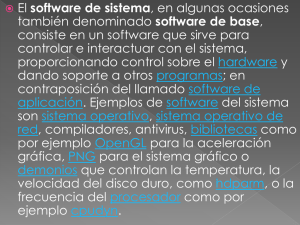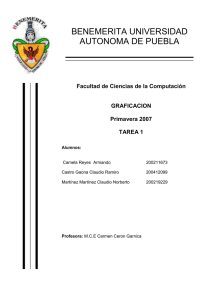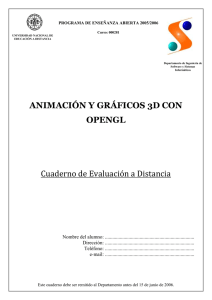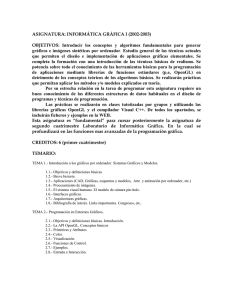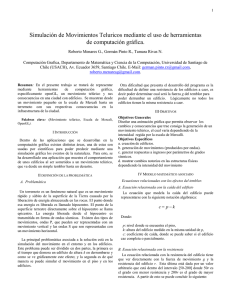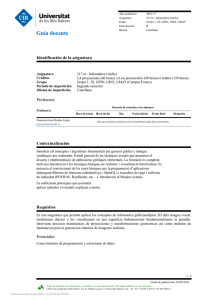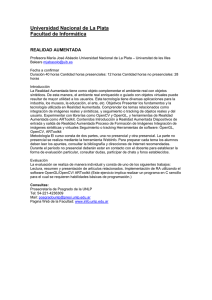Librerías Gráficas Introducción a OpenGL Introducción Definición de
Anuncio
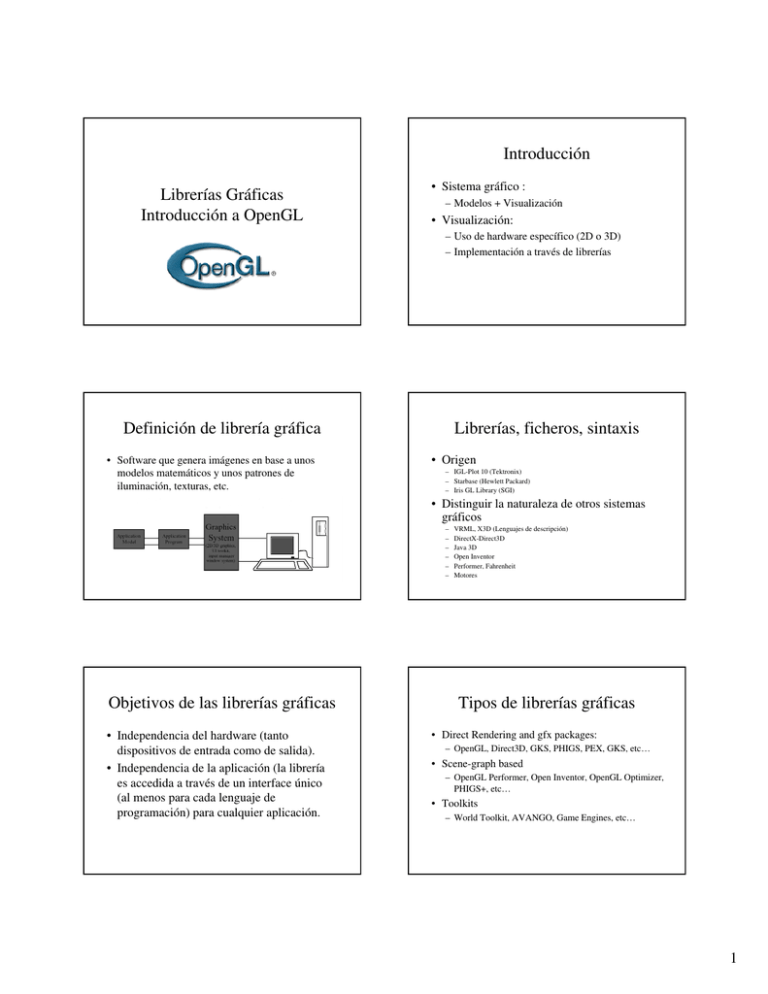
Introducción Librerías Gráficas Introducción a OpenGL • Sistema gráfico : – Modelos + Visualización • Visualización: – Uso de hardware específico (2D o 3D) – Implementación a través de librerías Definición de librería gráfica • Software que genera imágenes en base a unos modelos matemáticos y unos patrones de iluminación, texturas, etc. Librerías, ficheros, sintaxis • Origen – IGL-Plot 10 (Tektronix) – Starbase (Hewlett Packard) – Iris GL Library (SGI) • Distinguir la naturaleza de otros sistemas gráficos – – – – – – Objetivos de las librerías gráficas • Independencia del hardware (tanto dispositivos de entrada como de salida). • Independencia de la aplicación (la librería es accedida a través de un interface único (al menos para cada lenguaje de programación) para cualquier aplicación. VRML, X3D (Lenguajes de descripción) DirectX-Direct3D Java 3D Open Inventor Performer, Fahrenheit Motores Tipos de librerías gráficas • Direct Rendering and gfx packages: – OpenGL, Direct3D, GKS, PHIGS, PEX, GKS, etc… • Scene-graph based – OpenGL Performer, Open Inventor, OpenGL Optimizer, PHIGS+, etc… • Toolkits – World Toolkit, AVANGO, Game Engines, etc… 1 • Gestión imágenes 3D ... – “Bajo nivel” – “ Alto nivel” • Tareas • Tareas – Gestión “en serie” de los elementos de la escena – Elementos de la escena » Primitivas gráficas » “Atributos” (" edición imágenes) – Variables de estado Generación imagen • Sistemas – OpenGL – Direct 3D – Java 3D – “ Alto nivel” … DirectX Componentes • • • • • ... • (... Gestión imágenes 3D) DirectDraw DirectSound DirectPlay Direct3D .... DirectX - Introducción • Componentes incluidos en DirectX – Nos permiten desarrollar aplicaciones de alto rendimiento y en tiempo real • • • • • API Direct Play API Direct I nput API Direct Sound API Direct Draw API Direct 3D – – – – – – Gestión global de los elementos de la escena Árbol escena Carga/descarga de memoria Gestión elementos no visibles Elección del modelo geométrico: Nivel detalle, Textura Elección de la técnica de presentación (rendering) • Sistemas – – – – Inventor Performer ( Fahrenheit ) Hewlett Packard DirectX - Introducción • ¿Qué es DirectX? – Conjunto de API´s que permite a los desarrolladores de contenido interactivo (imagen, video, sonido...) acceder a características de hardware especializado sin tener que escribir código específico de hardware DirectX - Introducción • Objetivos de DirectX – Desarrollo de Aplicaciones Windows de alto rendimiento • Tarjetas aceleradoras • Plug´n Play • Servicios de comunicaciones construidos bajo Windows • Recursos instalados en el sistema – Utilización del nuevo hardware implementado 2 DirectX - Introducción • DirectX & COM (Component Object Model) • Obj et o: caja negra que representa el hardware y requiere comunicación con las aplicaciones a través de una interface. • Mét odo: comandos enviados y recibidos por el objeto a través de la interface COM – Ej.: Método Get DisplayMode es enviado a través de la interface I Direct Draw2 para tomar el valor de la actual resolución de la pantalla mediante el objeto Direct Draw DirectX - DirectDraw • Tipos de objetos – I Direct Draw – I Direct DrawSurf ace – I Direct DrawPalet t e – I Direct DrawClipper – I Direct DrawVideoPort DirectX - DirectSound • Componente de Audio de DirectX: – Mezclado de canales de audio – Aceleración hardware – Acceso directo al dispositivo de sonido – Captura de Audio DirectX - DirectDraw • Se encarga del manejo de la memoria de vídeo • Proporciona herramientas para – – – – – – Manipulación de múltiples buffers de vídeo Acceso directo a la memoria de vídeo Page flipping Back Buffering Manejo de la paleta gráfica Clipping DirectX - DirectDraw • Conceptos Gráficos y Técnicos – – – – – – – – – – – Bitmaps Superficies de dibujo (buffers) Page Flipping y Back Buffering Rectángulos Sprites Niveles cooperativos Modos de vídeo Buffers Overlays Clippers Video Ports DirectX - DirectSound • Interfaces COM – I Direct SoundBuf f er – I Direct Sound3DBuf f er – I Direct Sound3DList ener – I Direct SoundCapt ure – I Direct SoundCapt ureBuf f er 3 DirectX - DirectPlay • Simplifica el acceso de las aplicaciones a los servicios de comunicación • Otorga independencia para la creación de servidores de juegos • Comunicaciones – Peer-to-Peer – Cliente/Servidor DirectX - Direct3D • Interfaz gráfica para hardware 3D – Permitir gráficos tridimensionales interactivos en aplicaciones de Windows • 2 Modos: – Inmediato • API 3D de bajo nivel • Independiente del dispositivo • Programadores experimentados – Retenido (Obsoleta) • Desarrollo rápidos • Capa superior del inmediato DirectX - Direct3D • Conceptos Básicos – Sistemas de coordenadas 3-D • Left-handed (mano izquierda) • Podemos simular el right-handed DirectX - Direct3D • Conceptos Básicos – Triángulos – Reglas de rasterización de triángulos – Transformaciones 3-D • Traslación • Rotación • Escalado – Polígonos • Normales de cara y vértice • Modos de sombreado • Interpolaciones de triángulos OpenGL Objetivos de diseño de OpenGL: • Introducido en 1992 por SGI • Basado en IRIS GL, un API para workstations SGI • Es un open standard que ha sido adoptado ampliamente para todo tipo de aplicaciones gráficas • Se desarrolla bajo la supervisión del OpenGL architecture review board • API gráfico de altas prestaciones (con aceleración por hardware) • Posee cierta independencia del hardware • Es un API natural (en C) con posibilidad de extensibilidad 4 Se convierte en standard porque … Ventajas de OpenGL • • No trata de hacer demasiadas cosas: – Sólo renderiza la imagen, no gestiona ventanas, etc... – No posee animación de alto nivel, modelado, sonido, etc... • Hace lo suficiente: – Efectos de renderizado útiles y altas prestaciones • • • Fue promovido por empresas líderes en el sector (SGI, Microsoft, etc) Ventajas de OpenGL • • Evolving Because of its thorough and forward-looking design, OpenGL allows new hardware innovations to be accessible through the API via the OpenGL extension mechanism. In this way, innovations appear in the API in a timely fashion, letting application developers and hardware vendors incorporate new features into their normal product release cycles. Scalable OpenGL API-based applications can run on systems ranging from consumer electronics to PCs, workstations, and supercomputers. As a result, applications can scale to any class of machine that the developer chooses to target. Renderizado de OpenGL Industry standard An independent consortium, the OpenGL Architecture Review Board, guides the OpenGL specification. With broad industry support, OpenGL is the only truly open, vendor-neutral, multiplatform graphics standard. Stable OpenGL implementations have been available for more than seven years on a wide variety of platforms. Additions to the specification are well controlled, and proposed updates are announced in time for developers to adopt changes. Backward compatibility requirements ensure that existing applications do not become obsolete. Reliable and portable All OpenGL applications produce consistent visual display results on any OpenGL API-compliant hardware, regardless of operating system or windowing system. Ventajas de OpenGL • • Easy to use OpenGL is well structured with an intuitive design and logical commands. Efficient OpenGL routines typically result in applications with fewer lines of code than those that make up programs generated using other graphics libraries or packages. In addition, OpenGL drivers encapsulate information about the underlying hardware, freeing the application developer from having to design for specific hardware features. Well-documented Numerous books have been published about OpenGL, and a great deal of sample code is readily available, making information about OpenGL inexpensive and easy to obtain. Arquitectura OpenGL • Primitivas geométricas: – Puntos, líneas y polígonos • Primitivas de imágenes: – Imágenes y bitmaps • Pipelines separados para imágenes y geometría unidos mediante el mapeador de texturas • El renderizado depende del estado (luces, colores, materiales, etc) 5 Capacidades de OpenGL • • • • • • • Accumulation buffer A buffer in which multiple rendered frames can be composited to produce a single blended image. Used for effects such as depth of field, motion blur, and full-scene anti-aliasing. Alpha blending. Provides a means to create transparent objects. Automatic rescaling of vertex normals changed by the modeling matrix. BGRA pixel formats and packed pixel formats to directly support more external file and hardware frame buffer types. Color-index mode. Color buffers store color indices rather than red, green, blue, and alpha color components. Immediate mode. Execution of OpenGL commands when they're called, rather than from a display list. Display list. A named list of OpenGL commands. The contents of a display list may be preprocessed and might therefore execute more efficiently than the same set of OpenGL commands executed in immediate mode. Capacidades de OpenGL • • • • • • • • Double buffering. Used to provide smooth animation of objects. Each successive scene of an object in motion can be constructed in the back or "hidden" buffer and then displayed. This allows only complete images to ever be displayed on the screen. Feedback. A mode where OpenGL will return the processed geometric information (colors, pixel positions, and so on) to the application as compared to rendering them into the frame buffer. Level of detail control for mipmap textures to allow loading only a subset of levels. Materials lighting and shading. The ability to accurately compute the color of any point given the material properties for the surface. Pixel operations. Storing, transforming, mapping, zooming. Polynomial evaluators. To support non-uniform rational B-splines (NURBS). Primitives. A point, line, polygon, bitmap, or image. Raster primitives. Bitmaps and pixel rectangles. Capacidades de OpenGL • • • • • RGBA mode. Color buffers store red, green, blue, and alpha color components, rather than indices. Selection and picking. A mode in which OpenGL determines whether certain user-identified graphics primitives are rendered into a region of interest in the frame buffer. Specular Highlights. Application of specular highlights after texturing for more realistic lighting effects. Stencil planes. A buffer used to mask individual pixels in the color frame buffer. Texture coordinate edge clamping to avoid blending border and image texels during texturing. Capacidades de OpenGL • • • • • Texture mapping. The process of applying an image to a graphics primitive. This technique is used to generate realism in images. Three Dimensional Texturing. Three-dimensional texturing for supporting hardware-accelerated volume rendering. Transformation. The ability to change the rotation, size, and perspective of an object in 3D coordinate space. Vertex array enhancements to specify a subrange of the array and draw geometry from that subrange in one operation. Z-buffering. The Z-buffer is used to keep track of whether one part of an object is closer to the viewer than another. APIs relacionadas • GLX, WGL, AGX – Conexiones de OpenGL con el entorno de ventanas • GLU (OpenGL Utility library) – Es parte de OpenGL – Incluye soporte para cuádricas, NURBS, etc. • GLUT (OpenGL Utility Toolkit) – No forma parte oficialmente de OpenGL – Permite la portabilidad de las aplicaciones sobre distintos sistemas de ventanas APIs de OpenGL • Librería de funciones para generar imágenes a partir de modelos 3D, más otras librerías auxiliares – – – – gl la librería opengl relacionada directamente con el H/W glu librería de mayor nivel construida sobre opengl glaux librería fuera de uso glut librería para crear interfaces de usuario transportables (Linux, Windows, Unix en general, MacOS) • glut.dll windows\system(32) • glut.lib DevStudio\Vc\lib • glut.h DevStudio\Vc\include\gl • MESA: OpenGL clone 6 Arquitectura de APIs de OpenGL Detalles de programación • Añadir las librerías opengl32.lib glu32.lib glut32.lib – Project : settings : link : Object/Library Modules • Ficheros a incluir – #include <GL/gl.h> – #include <GL/glu.h> – If you are using GLUT for managing your window manager • #include <GL/glut.h> • Note that glut.h includes gl.h, glu.h, and glx.h automatically, so including all three files is redundant. Estados Command syntax (functions) • Máquina de estados – – – – – • – – – – Color de fondo Intensidad de luz Material de dibujo Luz encendida o apagada etc • – glColor*(), glGetFloatv() – glEnable(), glDisable(), glIsEnabled() Tipos variables y constantes • Las equivalencias más habituales aparecen en la tabla – Se recomienda definir los argumentos que se pasan a las funciones de OpenGL usando sus tipos predefinidos • Para Glint unos sistemas pueden usar short, otros long • Para Glfloat unos sistemas float otros double Typical Corresponding C-Language Type b 8-bit integer C-Language Type s 16-bit integer OpenGL Type i 32-bit integer int or long f 32-bit floating-point float d 64-bit floating-point double ub 8-bit unsigned integer unsigned char us 16-bit unsigned integer unsigned short unsigned int or ui 32-bit unsigned integer unsigned long OpenGL Type Definition GLbyte GLshort Glint GLsizei Glfloat GLclampf Gldouble GLclampd Glubyte GLboolean GLushort Gluint Glenum GLbitfield • gl tells that this function belongs to the “ gl” s/w package 3 is used to indicate three arguments f is used to indicate that the arguments are floating point v indicates that the arguments are in vector format Number Of Arguments: 2, 3, or 4 – – – • Valor o estado Data type glVertex3fv( ... ) Bi-dimensional version of the command 3D or rgb Homogeneous coordinates or rgb+alpha Formats – – absence of v indicates scalar format v indicates vector format Constantes • Ejemplo : GL_COLOR_BUFFER_BIT • Defined constants – Begin with GL_ – Use all capital letters – Use underscores to separate words • Con frecuencia se realizan operaciones “ or” 7 ... (gl) ... (glut) • pure "output", but lacks connection with display – – – – – – – – – – glClear glClearColor glBegin glEnd glVertex* glColor* glFlush, glFinish (command) (state) (geometry) (attribute, state) (command stack & processing) (debbuging) (mapping from modelling coord. to display coordinates) (aspect ratio) (need for a transformation management system) • Window system independent management – “ window” management • • • • glutInitDisplayModeg( GLUT_RGB | GLUT_SINGLE ); glutInitWindowSize( WIDTH, HEIGHT ); glutInitWindowPosition ( 550, 350 ); glutCreateWindow(“ Basic Draw"); – “ input” : event handling • similar to : The X Window system, MOTIF, MFF, ... • (event) • void Display(void); (callback function) • glutDisplayFunc( Display ); (binding event & callback) – void Display ( void ) • glutMainLoop(); (dispatching events) Primitivas ... • Otras primitivas disponibles – Objetos (uso auxiliar, no para crear modelos) – Vertex arrays – Display lists – Evaluators, NURBS, etc • Texto – No existe primitiva – Usar texturas, problema aliasing Atributos • • • • • • • • glPointSize(GLfloat) glLineWidth(GLfloat) glLineStipple(GLint factor, GLushort pattern) – glEnable( GL_LINE_STIPPLE ) glPolygonMode( face, mode ) – GL_FRONT GL_BACK GL_FRONT_AND_BACK – GL_POINT GL_LINE GL_FILL glPolygonStipple (enable) “ transparency” glEdgeFlag* mode Line, splitted concave polygons glColor* glMaterial* Variables de estado • Valor de defecto • Valor actual • Gestión en una aplicación o en un módulo reutilizable – Valor de defecto en una aplicación dada – Política de cambios de estado en un módulo de software • glPushAttrib( ored mask ) / glPopAttrib() – Permiten salvar grupos de atributos 8 Grupos de atributos GL_ACCUM_BUFFER_BIT accum-buffer GL_ALL_ATTRIB_BITS -- GL_COLOR_BUFFER_BIT color-buffer GL_CURRENT_BIT current GL_DEPTH_BUFFER_BIT depth-buffer GL_ENABLE_BIT enable GL_EVAL_BIT eval GL_FOG_BIT fog GL_HINT_BIT hint GL_LIGHTING_BIT lighting GL_LINE_BIT line GL_LIST_BIT list GL_PIXEL_MODE_BIT pixel GL_POINT_BIT point GL_POLYGON_BIT polygon GL_POLYGON_STIPPLE_BI T GL_SCISSOR_BIT polygon-stipple GL_STENCIL_BUFFER_BIT stencil-buffer GL_TEXTURE_BIT texture GL_TRANSFORM_BIT transform GL_VIEWPORT_BIT viewport Purpose of Command • Arrays – Evitar pérdidas de tiempo en llamadas a funciones • Display Lists – Ídem – La información puede está preprocesada – Almacenar en el procesador gráfico para aliviar el bus • Workstations • PCs scissor Comandos entre : glBegin-glEnd Command Agrupamiento Reference glVertex*() set vertex coordinates Chapter 2 glColor*() set current color Chapter 5 glIndex*() set current color index Chapter 5 glNormal*() set normal vector coordinates Chapter 2 glEvalCoord*() generate coordinates Chapter 11 glCallList(), glCallLists() execute display list(s) Chapter 4 glTexCoord*() set texture coordinates Chapter 9 glEdgeFlag*() control drawing of edges Chapter 2 glMaterial*() set material properties Chapter 6 Ejemplo : Window to viewport • gl – – – – – glMatrixMode glLoadIdentity viewport glOrtho glGetIntegerv • glut – glutReshapeFunc( myNewSize ) • void myNewSize( int w, int h ) Links Interesantes • ww w.opengl.org Official sit e of OpenGL • nehe.gam edev.net NeHe, various OpenGL t ut orials • rom ka.dem onews.com Rom ka, various OpenGL t ut orials • Nexe.gam edev.net sam e as Nehe for Dirext X 9
